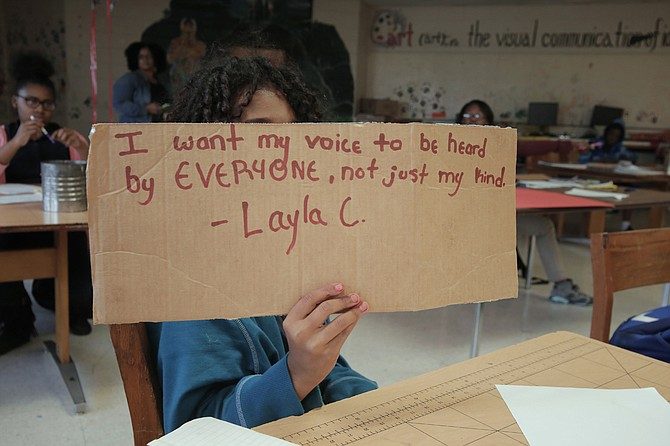By Sierra Mannie/The Hechinger Report
JACKSON, Miss. – Siwell Middle School art teacher Cassandre Connolly taps keys on her computer and the projector splotches the wall with President-elect Donald Trump’s smiling face. Her classroom of sixth graders erupts at once into groans. All are black or Hispanic except for Orion, who is Venezuelan and Israeli; his cousin teaches him Hebrew on the weekends.
“Rigged, I tell you!” yells Julian, 12, who is Latino, as he points gleefully at the front. “Rigged!”
The assignment accompanying Trump’s face asks the students to consider four tweets about Trump and the election in which he bested former Secretary of State Hillary Clinton to win the office of President of the United States.
TRUMP rocked.
WORLD shocked!!— Iqraaa (@chasmish_Ed) November 9, 2016
Don’t forget to set your clocks back tomorrow, a couple hundred years.
— TobiasVanSchneider🐼 (@vanschneider) November 9, 2016
This isn’t an episode. This isn’t marketing. This is reality.
— Black Mirror (@blackmirror) November 9, 2016
Making America Great Again pic.twitter.com/sjNEpoWls6
— Jon Langston (@JonTLangston) November 9, 2016
From there, the students wrote their interpretations of what the posts meant.
Ricardo, 11, who is black, says “making America great again” is just “sarcasm” on Trump’s part. “How is a person who has no understanding of presidency and has no etiquette going to make America better?” he asked in his response. “How can we let a man who lost his mind in the presidential seat?”
Michael, 11, who is also black, didn’t understand that quote, either. Or how Trump won.
“Black people don’t vote for white people unless they’re like cool,” he read from his paper. “He said what people wanted to hear, and they voted for him. Also, don’t tell anybody this, but I cried in the bathroom this morning when I found out.”
A group of boys to his left burst into laughter and called him a crybaby. His teacher, a white Manhattanite living in Mississippi and serving her second year in Teach for America, however, was sympathetic.
“Don’t let anyone make you feel bad,” she said. “I cried, too.”
‘Back to Africa’
The electorate of the United States, and the voters who elected Donald Trump, do not resemble the demographics of the country’s public schools.
The Pew Research Center projected in February that 69 percent of the voters who came to the polls last Tuesday would be white; CNN exit polls for the election said about 70 percent of voters were white.
In contrast, 49.7 percent of the nation’s public schools are now white. Nonwhite children have been the majority of American public-school students since 2014.
In Mississippi, a deeply red state, 44.76 percent of public-school students are white, compared to the 49.22 percent who are black. The remaining 6 percent are a mix of non-white Hispanics, Asians, Native Americans, Pacific Islanders and multi-racial students. But the state’s population is 37 percent black, with whites making up 58 percent of the population, U.S. Census data show.
The nation’s deeply segregated schools, including the ones in Jackson, have made the election even more confusing and disturbing for many children who rarely encounter others who don’t look and think like them. Mississippi voted overwhelmingly for Trump.
But at schools like Siwell that serve mostly black and Hispanic students, kids can’t understand how a candidate who received an endorsement from the Ku Klux Klan could have won. Many of the students said their knowledge about Trump came from what their friends told them.
“I thought Trump was racist,” one black student told the class.
“I thought he was going to send us back to Africa.”
“He doesn’t have the power,” another student assured him.
‘Crying Like Babies’
As for Hillary Clinton, who fell to Trump in the Electoral College while winning the popular vote, the students seemed impassive. Julian said he did not know much about her, just that she did not seem “as bad.” Layla, a 12-year-old black student, said Clinton’s loss meant that maybe she could be the first female president, now.
 Future president Layla/Imani Khayyam
Future president Layla/Imani Khayyam
As her students wrote and drew pictures about what a Trump presidency would mean for them, their families and their futures for their final assignment of the day, Connolly said she voted for Clinton. She, her roommates and a friend watched the election results with increasing despair. “Five grown women, four teachers and a lawyer, crying like babies on the couch,” she said.
But Connolly says it is important for her, as a white person, to make moves to bridge the gap of trust between herself and her students, especially when they might feel threatened by what they don’t understand.
“When tragedy strikes, my voice needs to be louder. Their lives are the ones going to be affected more than the women’s on the couch.”
Sierra Mannie is an education reporting fellow for the Jackson Free Press and The Hechinger Report. E-mail her at sierra@jacksonfreepress.com.
–
See also:
* Schoolchildren “Have A Lot Of Questions And A Lot Of Fear” In Aftermath Of Trump Victory.
* The Mystery Of President-Elect Donald J. Trump And His Election Agenda: ‘There’s Not Much More.’
* Educators Ponder Meaning Of A Trump Presidency: Plea For ‘The Vulnerable And The Bullied.’
* After Shocking Election, New York History Teacher Tries To Alleviate ‘Despair, Anxiety Or Indignation.’
* How Can Education Reform The Minds Of Trump Voters?
* If The Anger That Propelled Trump’s Win Is Economic, Can Higher Education Fix It?
* Like It Or Not, Trump Is The Next President – Now, Here’s How He Can Improve Higher Ed.
* Trump Plan Would Base Student Loans On Employability.
* “Educational Choice” Is A Slogan Slick Enough For Donald Trump.
* Why The Election Matters For Immigrant Students.
–
Comments welcome.
Posted on November 17, 2016


